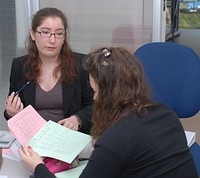International Hotel & Tourism Management Academy

Prerequisite : 3-year program (Bachelor, Masters in any discipline).
Language of instruction : English
Duration of the program : 2 years (6 months for AIM’s BS or BA holders).
State Quality Certified Program

French State recognition leading to AIM’s Bachelor degrees.
Holders are officially entitled by this recognition as:
Directeur d’établissement de luxe en hôtellerie internationale (RNCP-Niv. 7).
In other terms: Director for International Luxury Hotels.
State approved renewal process of recognition: June 28, 2024

AIM offers high-quality professional training programs taught in English aimed at preparing students for management roles in leading international hotels and supervisory positions in tourism-related sectors.
AIM’s MSc graduates are particularly sought after by recruiters thanks to the high-quality teaching programs enhanced by industry internships in management, making them immediately operational and in line with labor market needs upon graduation from the school.

The Master of Science is a continuation of our Master of Science (MS) program that has been taught at AIM since 1992.
It serves to expand on AIM’s Bachelor of Science program, providing more in-depth analysis, specifically in the field of management of high-end hospitality establishments.
The training is enhanced by professional applications:
Master of Science students have already completed higher education studies, either in hospitality (the MSc develops their knowledge in this area), or else in the Sciences, Arts, Business Administration or Humanities (the MSc is chosen by candidates seeking a career change).
Successful candidates should have professional experience, a good command of foreign languages and a broad general knowledge.


The program presents financial accounting concepts and shows how they apply to the hospitality industry. It incorporates the most recent formats, information, and schedules from the newly-published Uniform Systems of Accounts for the Lodging Industry.

This course presents basic financial accounting concepts and explains how they apply to the hospitality industry.
This course presents a systematic approach to human resources management in the hospitality industry. Students will analyze contemporary issues and practices, as well as employment laws that have an impact on the way people are managed.
[ TOPICS ]

This course provides students with practical skills and knowledge for effective management of food service operations. It presents basic service principles while emphasizing the importance of meeting and, whenever possible, exceeding the expectations of guests.


This course presents a systematic approach to managing Rooms Department in large and luxury international hotels by detailing the flow of business from the reservations process to check-out and account settlement. The course also examines the various elements of effective Housekeeping Management, paying particular attention to the planning and Human Resources Management.
[ TOPICS ]
 This course is designed to provide students with a solid background in hospitality sales and marketing. The main focus is on practical sales techniques for selling to targeted markets.
This course is designed to provide students with a solid background in hospitality sales and marketing. The main focus is on practical sales techniques for selling to targeted markets.
At the completion of this course, students should be able to:

This course is designed to provide students with the principles of supervision as they apply specifically to the hospitality industry.
The purpose is to give students elementary knowledge & practice of management issues, including recruitment, training, performance evaluation, supervisory concerns, effective communication.
The students will learn & practice in class different techniques to be ready to face line-manager responsibilities in the first years of their career in the Hospitality Industry.
1. Identify fundamental supervisory responsibilities.
2. Explain the steps that supervisors can take to speak effectively on the job.
3. Describe how supervisors work with the human resources department to recruit new employees.
4. Explain the function of training within an organization and the supervisor's role in training.
5. Forecast business volume using the base adjustment forecasting method and the moving average forecasting method.
6. Distinguish coaching from counseling and disciplining.
7. Identify the components of a progressive disciplinary program.
8. List important laws and legal concerns that affect hospitality supervisors.
9. Describe issues supervisors should be aware of as they assume the role of team leader.
10. Explain how supervisors can increase employee participation in department activities.
11. Identify steps supervisors should follow during a meeting with employees in conflict.
12. Distinguish high-priority interruptions from low-priority interruptions, and summarize strategies for dealing with the latter.
13. Describe actions that supervisors can take to minimize employee resistance to change.
Explain why it is important for supervisors to take control of their personal development, and describe how to execute a career development plan.
At the end of the session, students should be in the position to:
This course provides a thorough look at training by addressing how to assess and analyze the training needs of new and established operations; look upon training and development as an investment; use training tools and techniques; train with technology; measure and evaluate training; and use different training techniques when training employees, supervisors, and managers.
[ CONTENTS ]

Students should already be familiar with financial accounting concepts and procedures,
This course presents managerial accounting concepts and explains how they apply to specific operations within the hospitality industry.
At the completion of this course, students should be able to:
This course describes how to develop and implement an effective purchasing program, focusing on issues pertaining to supplier relations and selection, negotiation, and evaluation. The course includes in-depth material regarding major categories of purchases.
[ TOPICS ]

Hospitality managers are charged with making strategic and proactive decisions to increase occupancy rates and total revenue for their properties.
Applying a systematic process to such decision-making can increase their success.
This certificate program in hotel revenue management, developed by renowned revenue management expert Dr. Sheryl Kimes of Cornell’s School of Hotel Administration, provides a holistic view
of the application of hotel revenue management concepts and practices to the hospitality industry.
The courses focus on several high-impact drivers for maximizing revenue: forecasting and availability controls, pricing and distribution channel management, overbooking and group management, and non-traditional revenue management applications. Each course explores a topic in depth, with particular emphasis on the role of strategy in effective revenue management and the practical application of tools and techniques in the hospitality setting.
Implementing a revenue management strategy can be one of the most important revenue-generating initiatives available to a hotel, significantly increasing room revenue and profits. This course provides an overview of revenue management applications to the hotel industry designed to inspire a strategic shift to managing revenue per available room (RevPAR).
Revenue management is a systematic process designed to increase revenue by selling the right room to the right person at the right time for the right price. In addition to evaluating different pricing models and applying duration-management strategies, this course provides a foundation for more advanced revenue management courses in forecasting, group management and overbooking, pricing strategy, and application of revenue management techniques to other hospitality-related industries including spas and athletic facilities.
Participants who complete this course will be able to:
All successful revenue management strategies are based on the ability to forecast demand accurately and control room availability and length of stay.
This course explores the role of the forecast in a comprehensive revenue management strategy, including the selection of the best type of forecast and the impact of forecasting on other functions such as labor scheduling and purchasing. It presents a step-by-step approach to the mechanics of creating an accurate forecast. Participants learn how to build booking curves; account for “pick-up”; segment demand by market, group, and channel; and calculate error and account for its impact. The course also explores the impact of availability controls, including length-of-stay management, on revenue management and how they can be leveraged.
Participants use Microsoft Excel to practice forecasting and availability control techniques.
Participants who complete this course will be able to:
Pricing is one of the most powerful tools a hotel can use to increase revenue. This course teaches you how to set the right prices, develop rate fences (differentiate prices by customer type), and use multiple distribution channels to manage price more effectively. You’ll learn about the impact of variable pricing and discounting on revenue management in the context of price elasticity, optimal price mix, perceived fairness, and congruence with positioning and sales strategies.
Channel management is an essential tool for controlling differentiated pricing, maintaining rate fences, and increasing revenue. You’ll explore various approaches to managing distribution channels including direct sales, agencies, the Internet, and opaque pricing channels.
Finally, discussions of best practices and industry case studies help you extend and contextualize your learning experience.
Participants use Microsoft Excel to practice pricing and distribution-channel-management techniques.
Participants who complete this course will be able to:
Businesses that accept reservations must cope with the problem of no-shows: customers who make a reservation but fail to honor it. Hotels can protect themselves against revenue lost from no-shows and generate increased revenue by overbooking. This course teaches you how to strategically overbook and how to manage issues associated with overbooking, as well as how to evaluate groups and determine which rates to charge.
This course explores the components of a successful overbooking strategy including no-show forecasting, no-show rates, arrival uncertainty, pricing policies, and cancellation forecasts. It explores the risks of overbooking and presents strategies to minimize costs and mitigate customer impact.
To fully realize your property’s revenue potential, you must be able to manage group reservations. This course teaches you how to create a group forecast and explores yieldable and non-yieldable business and incremental group costs and revenue opportunities. It introduces models to calculate displacement costs and contribution margins to determine which groups are most profitable.
Participants who complete this course will be able to:
Revenue management can be applied to any industry with relatively fixed capacity, time-variable demand, and perishable inventory. This course teaches you how to apply revenue management concepts and practices to hospitality-related industries such as restaurants, meeting spaces, spas, and golf facilities. You’ll learn a step-by-step process to develop, implement, and monitor a revenue management strategy to maximize top-line revenue.
Participants who complete this course will be able to:

Students learn:
Includes the analysis and interpretation of financial information to make better-informed decisions. This understanding includes reviewing concepts and tools such as:
Emphasis is placed on the fact that accounting is not just numbers, but rather a powerful tool to better manage people, performance, and profit.
The Finance segment focuses primarily on issues below Gross Operating Profit (GOP). This includes a discussion of the impact of the owner’s decisions on the hotel’s performance including financial leverage. The analysis concentrates on the economic assessment from the owner’s perspective and presents a clearer understanding of owner’s measures of success and investment criteria including:

A comprehensive training program on hotel and tourism research.
Participants demonstrate step-by-step analytical skills, observe a range of case scenarios and then apply what they have learned to complete their own comprehensive research project.
The training can be personalized related to a geographic area, type of research or related to specific needs.
The program includes five modules:

Strategic and Marketing approaches that proved successful in the past may not apply to our new hospitality world: customers’ needs evolve constantly and organizations have to identify “blue oceans” of new demands to generate revenue, profit and growth.
For the Marketing and Entrepreneurial Development course, students are organized in small groups and are confronted with 3 challenges:
- A Creative Challenge by Identifying a profitable New Product Idea, around the Hospitality and Tourism world .
- A Business Challenge by Writing up a full Business Plan from the market need identification to the competitive environment, up to the recommended strategy and all product tactics necessary to achieve the chosen objective. A 3 year P&L projection completes the exercise.
- A Self-assertiveness Challenge by Pitching their group Business Plan in front of a Jury to confirm their ability to present convincingly and answer questions from “could be” Business Angels : thus, a complete preparation to future professional presentations.

N.B. : The organization of certain management courses may be modified depending on the schedule of certain visiting professors.
Two years of high-quality, intensive, and specialized higher education in preparation for operational management roles in luxury hospitality and high-end tourism sector. Taught in English.
| Oct. | Nov. | Dec. | Jan. | Feb. | Mar. | Apr. | May | Jun. | Jul. | Aug. | Sept. | Oct. | Nov. | Dec. |
| COURSE | MANAGEMENT TRAINING * |
Christmas holidays: 2 weeks in accordance with the Academy of Paris calendar
Winter holidays: 2 weeks in accordance with the Academy of Paris calendar
*Management training: 6 months in France, up to 8 months outside France
| Jan. | Feb. | Mar. | Apr. | May | Jun. | Jul. | Aug. | Sept. | Oct. | Nov. | Dec. |
| COURSE |
 |
*Management Training: non-compulsory but may be undertaken with a three-party agreement
The timetable for the two-year duration permits part-time work restricted to 20 hours weekly.

Teamwork for real projects, with rigorous planning requiring in-depth knowledge,
all provided during the program.
Thanks to the free membership to the CIUP Library provided by AIM, students have the opportunity to develop their skills in a foreign language of their choice from a catalog of more than 26 languages.
 Located on the campus of the Cité Internationale Universitaire of Paris, the Espace Langues welcomes AIM students from Monday to Friday and provides excellent facilities for the acquisition and practice of foreign languages with general conversation, business communication, grammar, written and oral expression and understanding, pronunciation and advanced levels.
Located on the campus of the Cité Internationale Universitaire of Paris, the Espace Langues welcomes AIM students from Monday to Friday and provides excellent facilities for the acquisition and practice of foreign languages with general conversation, business communication, grammar, written and oral expression and understanding, pronunciation and advanced levels.
The Languages Area provides instruction in:
French
English
Spanish
Italian
Portuguese
Turkish
Arabic
Hebrew
Chinese
Farsi
Urdu
Dutch
Japanese
Korean
Armenian
Hindi
Russian
Greek
AIM benefits from a partnership with the AHLEI which provides certification that AIM’s courses meet the highest international standards in higher education.
Particularly intended for professionals wishing to broaden their skills, they enable our students to accelerate access to jobs at international level depending on their profile.
The AHLEI is internationally recognized for its consultancy services and implementation of the best management tools in major international hotel chains.
To cite just one, the Uniform System of Accounts for Hotels, an accounting system for the hotel industry that it designed and published, is used by all major establishments, both in France and internationally.